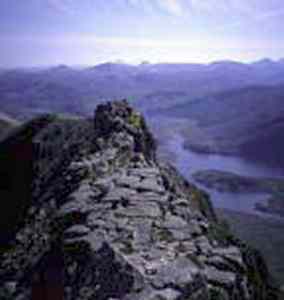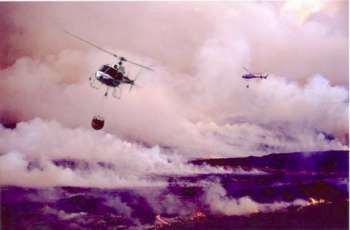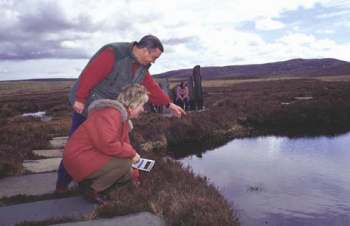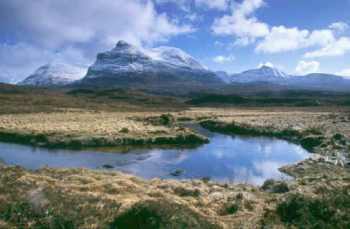 | Caithness.Org | Community | Business | Entertainment | Caithness... | Tourist Info | Site Map |
• Advertising • Chat Room • Contact Us • Kids Links • Links • Messageboard • News - Local & Scottish • News - UK & News Links • About / Contact Us • Submissions |
• Bookshop • Business Index & News • Jobs • Property For Sale • Property For Rent • Shop • Sutherland Business Index |
• Fishing • Fun Stuff • George, The Saga • Horses • Local Galas • Music • Pub Guide • Sport Index • What's On In Caithness |
• General Information • B & Bs • Backpackers • Caravan & Camping • Ferries • Getting Here • Holiday Letting • Hotels • Orkney • Pentland Firth • Sutherland • Taxis |
| N E W S F E E D S >>> |
The Sutherland
Biodiversity Action Plan - October 2003
MOUNTAIN AND MOOR
|
1.5 MOUNTAIN & MOOR Introduction Sutherland’s mountains are
concentrated along a line parallel to the west coast, from Seana Bhraigh
in Kincardine, north to Foinaven with the outliers of Ben Hope, Ben Loyal
and Ben Klibreck further to the
Specific habitats discussed in Section 2 Key issues A. Overgrazing and inappropriate burning Issues: In certain areas, High deer and sheep numbers, and a decline in shepherding, have resulted in overgrazing which has lead to increases in rough grassland at the expense of heather moorland. This may cause localised erosion and run-off. Traditional land management such as muirburn and domestic peat cutting have modified much of the peatland habitat and contributed to the landscape pattern we see today. Controlled strip-burning of heather moorland can benefit grouse and some species of moorland bird (e.g. meadow pipit, skylark). However, burning of other habitats such as blanket bog, scree and woodland, can cause lasting damage and uncontrolled muirburning is a major problem in some parts of Sutherland.
Opportunities: Numbers of red deer and sheep
should be managed to appropriate levels, with assistance from schemes such
as the Rural Stewardship Scheme and the implementation of agreed Deer
Management Plans. Training and encouragement of best practice in
muirburning is needed, along with support for burning plans covering
common grazings and enforcement of legislation when guidelines are
ignored. Most of the Current projects: Numbers of deer and sheep are controlled for sporting and welfare purposes, and the Deer Commission Scotland, Scottish Natural Heritage, estates and conservation bodies are working together on the production of Deer Management Plans, which help neighbouring estates to manage their deer numbers. The Royal Society for the Protection of Birds manages an extensive peatland Reserve for its conservation interest at Forsinard. In addition to its positive management for conservation, the Reserve is used for survey and monitoring work, and as a teaching resource by many Primary Schools throughout the county. Opportunities: Some forest plantations on deep peat are being restructured or clear felled and the ground restored to peatland habitats through initiatives such as the LIFE Peatlands Project. Consideration should be given to the balance of woodland and moorland land uses but in general, natural regeneration of native broadleaves onto heather moorland, particularly along burns and rivers, should be encouraged. Populations of foxes and crows should be controlled where they have an adverse impact on grassland and moorland species. Current projects: The LIFE Peatlands Project has undertaken a number of practical projects to improve peatland habitats, including drain blocking and the removal of inappropriately planted forestry and subsequent restoration of peatland. The project has also undertaken a number of awareness-raising initiatives, and is working on a land use strategy for the peatlands of Caithness and Sutherland.
|
B. Balance between moorland and woodland land uses Issues: Large-scale
afforestation is no longer a major issue threatening the blanket bog of
Caithness & Sutherland, but some peatland areas are drying out because of
nearby plantations and drains. Increases in native woodland and natural
regeneration schemes are leading to increased consideration of the balance
between open ground and woodland. Commercial forestry and grant aided
natural regeneration requires a reduction in grazing Opportunities: Some forest plantations on deep peat are being restructured or clear felled and the ground restored to peatland habitats through initiatives such as the LIFE Peatlands Project. Consideration should be given to the balance of woodland and moorland land uses but in general, natural regeneration of native broadleaves onto heather moorland, particularly along burns and rivers, should be encouraged. Populations of foxes and crows should be controlled where they have an adverse impact on grassland and moorland species. Current projects: The LIFE Peatlands Project has undertaken a number of practical projects to improve peatland habitats, including drain blocking and the removal of inappropriately planted forestry and subsequent restoration of peatland. The project has also undertaken a number of awareness-raising initiatives, and is working on a land use strategy for the peatlands of Caithness and Sutherland. C. Other management issues Issues: All-terrain vehicles can be damaging to some of the wetter and steeper areas, leading to increased erosion. In drier areas damaged by fire or erosion, expansion of bracken can be a threat. Ticks are a major issue to moorland birds and animals in some areas. Egg theft and illegal persecution of birds of prey is a problem in some localities. Opportunities: Gamekeepers and stalkers play a key role in effective moorland management, and should be retained as key partners in the management of moorland and hill-land for biodiversity. Current projects: Scottish Natural Heritage has been running a Peatland Management Scheme for over ten years. The Scheme pays land managers to manage the peatlands according to an agreed plan, and is now being taken forward under SNH’s Natural Care Scheme. D. Recreation and path maintenance Opportunities: Continued support is needed for path maintenance works, and initiatives that guide visitors away from the most sensitive areas, awareness raising to ensure dogs are kept on leads during nesting season, etc. Current projects: Many estates already
undergo a programme of path maintenance, but funds for such works are
currently restricted and it is anticipated that demand will increase with
changes to access legislation. The Highland Access Project is
E. Renewable energy Issues: There has been an increased interest in renewable energy in recent times, with wind farms and small hydropower schemes representing the most favoured options. Some bird species are thought to be sensitive to the erection of high structures such as wind turbines or pylons near to their breeding sites, and altering the flow of some rivers and streams could have an adverse effect on the migration of salmon and sea trout, spawning beds and fresh-water pearl mussels. Opportunities: Consideration should be given
to mapping areas where wind or hydro power proposals would be detrimental
to biodiversity, and identifying sites where they would cause minimal
|













